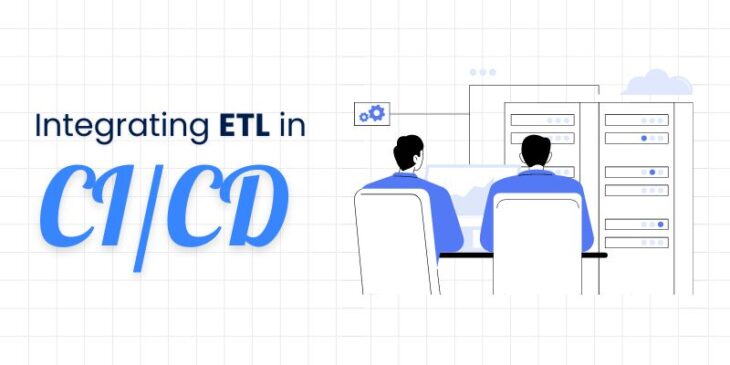
ETL plays a major role in the lifecycle of data management and analytics as it unites different sources of data, assures data quality and gives a bird’s eye view of the data for analysis and decision-making. ETL stands for data handling operations- Extract, Transform and Load. It is a procedure applied in the field of data warehousing and analytics which aims to bring data from several sources, transform them into a consistent format and project them to a destination database or data warehouse meant for data analysis, reporting and decision-making.
As businesses continue to embrace information-driven decision-making to boost digital transformation initiatives, the merging of ETL with CI/CD pipelines will remain an important precedence. The integration of ETL procedures into CI/CD pipelines plays a critical role in improving the speed, reliability and scalability of the data integration process.
Here, in this blog, we’ll explore productive techniques to build ETL processes and the benefits of integrating ETL into the CI/CD pipeline. Starting from devising painless criteria and setting up robust systems to relying on containerization and orchestration tools, every single step plays a significant role in making sure that ETL workflows smoothly integrate into the development pipeline and help in data pipeline development with CI/CD.
The integration of ETL into the CI/CD pipeline represents a strategic move for cutting-edge businesses seeking to maximize their growth. By embracing quality practices and adapting them to the enterprise’s precise needs, businesses can easily embark on a journey towards information-driven excellence.
Benefits of Integrating ETL in CI/CD Pipelines
As more organizations move to intelligent business operations, ETL integration into the CI/CD pipeline serves as a strategic weapon to increase revenue. Here are the benefits of integrating ETL in CI/CD pipelines.
- Speed and Agility: Organisations have to link ETL processes with CI/CD pipelines so that these processes can contribute to the rapidization of the data-centric insights and applications within CI/CD. Data Pipeline Development with CI/CD enables fast iterations, rapid feedback cycles and agility in responding to unexpected business modifications.
- Consistency and Reliability: CI/CD pipelines are committed to ensuring consistency at each stage and provide a mechanism for the execution and automation of ETL development. Automation of ETL scripts gives confidence that the data processed is reliable, predictable and consistent, thereby reducing mistakes or anomalies.
- Visibility and Transparency: The ETL and CI/CD tools ensure that the build ETL processes can be viewed transparently. This setup guarantees that teams can assess the changes, track the KPIs and solve the issues early before communication and collaboration between engineers, developers and other stakeholders are done.
- Scalability and Resilience: The adoption of ETL techniques leads to system scalability and resilient pipeline deliveries. Data transformation with automated and code-driven ETL workflows makes large amounts of data objective for continuous growth while solving the challenges of reliability and performance.
- Security and Compliance: Integrity and compliance of data are the most important aspects of the digital world. In the case of traditional ETL integrated with CI/CD pipelines, data security policy, automatic scanning of data security and maintaining data compliance during the development cycle results in a reduction of data security breaches and violations of regulations.
- Cost Optimization: CI/CD practices automate manual operations, an approach that facilitates optimization and reduces costs by cutting down deployment failures and optimizing resource utilization. Through the integration of ETL processes in CI/CD pipelines, organizations can automatize their activities, optimise resource utilization and enhance the quality of information received from databases.
The Conclusion
Using the ETL procedures along with a CI/CD pipeline and CI/CD tools is an excellent option to improve the reliability, scalability and throughput of data integration workflows. Here, in this blog, we’ve delved into the multifaceted advantages of integrating ETL within CI/CD workflows. By seamlessly integrating data extraction, transformation and loading stages into the delivery pipelines, businesses can achieve greater efficiency, agility and reliability in deploying data-driven applications.



